Rippon Lea Estate and its link to the history of Clivia in Victoria
Rippon Lea Estate and its link to the history of Clivia in Victoria
Michael Barrett
Continuing on from earlier presentations to the MCG of Clivia identities and plants associated with them, (G.K. Cowlishaw, presentation Feb 2013, article Vol 6.2, Sir Peter Smithers and Sir John Thouron- Clivia ‘Vico Yellow’ C. ‘Sir John Thouron’ April 2015, Vol 8.3, and Clivia in California, April 2016, Vol 9.2), I wanted to investigate and shine light on two individuals, James Dearing and Fred Pollard, both associated with the well-known Clivia ‘Aurea’. To do so, I wanted to establish the horticultural context James Dearing was influenced by and lived in. Firstly, I will discuss an aspect of plant collecting in Victorian society, fern fever, also known as pteridomania. Secondly, I will give an overview of the passionate horticultural persuasions of two owners of Rippon Lea estate where James Dearing worked. Thirdly, I will briefly discuss Fred Pollard and the garden plant mail order business he ran, selling amongst other things, Clivia. Finally, I take a look at some of the influence C. ‘Aurea’ has on current collections.
Victorians mad on plant collecting.
Queen Victoria ascended to the throne of the United Kingdom and its colonies in 1837 and reigned for the next six decades, in what is referred to as the Victorian era. While far from ideal, over the course of Queen Victoria’s reign, the health and lifestyle of the British citizen improved, as did the power of Britain on the back of scientific developments and a united empire. Discoveries of raw materials, new plants and the benefits of commerce in the colonies across the empire were ‘brought home’. Industrialization led to the increase of wages, and the availability of mass produced household items. Leisure time for the working class increased, as hours worked declined with better pay, bank holidays, and annual leave. Improvements to the rail transport system allowed city folk to holiday in seaside resorts, and enjoy the brass band at the bandstand.
Another type of activity that was encouraged amongst the working class was an interest in natural histories. Amateur scientists, inspired by professionals such as Charles Darwin, enjoyed the pastime of collecting all manner of items including rocks, shells, birds, their feathers and eggs. Those with an interest in plants became amateur botanists. Leaves and flowers were gathered and pressed. Some of the wealthiest people became patrons to plant collectors to explore the world for new varieties of various genera, with orchids being very popular as a signal of taste and
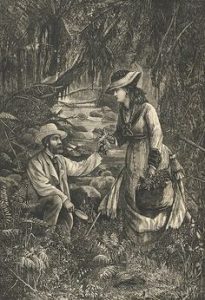
wealth. However, the majority of the working class amateur botanists were captivated by a fern fever, later to be described in 1855 by Charles Kingsley, as pteridomania. Peter A. Boyd suggests that “no other single craze affected so many Victorian or such a cross section of society.” With improved transport, men and women went into the countryside in Britain, Australia and New Zealand seeking out ferns to gather and bring home to grow or press in albums. Some sources suggest the mixed gender social aspect of time spent collecting ferns in relatively private settings was as much an appeal as were the ferns.
Books to aid the identification of species were published and sold well. The fern fever led to commercialisation of specialist dealers and nurseries to supply material to satisfy the craving for more ferns. The passion for ferns influenced decorative arts, with the ferns becoming “a symbol of pleasurable pursuits” in all manner of mass produced items including, glassware, pottery, paper, textiles and cast iron. The Coalbrookdale Company mass produced the popular ‘Fern and Blackberry’ design from the 1870s to the 1890s and copies are reproduced today. The flat structure of fern leaves lent themselves to being used on both flat and curved designs.
In dimly lit, gassy, but heated drawing rooms, ferns struggled to survive until the newly designed Wardian case became a must for any fashionable drawing room. The glazed glass and metal container, that was a forerunner to the terrarium, was inspired by an accidental observation and designed by Dr Nathaniel Bagshaw Ward. The sizes ranged from very small to very large with elaborate designs. The concept was also used to bring plants back from the colonies. It created the perfect micro climate for growing ferns and some other moisture loving plants in a domestic setting. Meanwhile, city councils, botanical gardens and the very wealthy built a variety of structures to collect, present and maintain extensive fern collections, many being very popular tourist destinations.
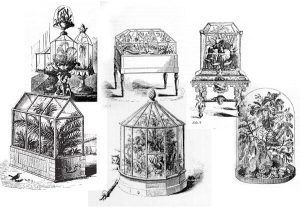
In Melbourne, an excellent surviving example of a once private fernery can be found at the magnificent Rippon Lea estate. The Australasian (10/12/1910) reported the gigantic fernery at Rippon Lea (built in the 1870s), cost Sir Frederick Sargood £2000 to build. Graeme Purdy, writing in Your Garden, September 1988, provided details of the fernery at Rippon Lea that had just undergone a major four-year refurbishment at a cost of $333,000. The structure is 15 meters wide, 45 meters long, with steel ribs arching 12 meters overhead and having numerous red cedar slats evenly spaced to provide shade. An in-ground sprinkler and overhead misting system are in place. There is running water in the form of a creek, with naturalistic placement of rocks throughout. Importantly, Purdy notes that in Victorian times, the fernery was not a purist display, and he includes Clivia among the other plants used to provide harmony and interest.
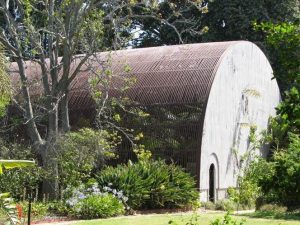
Rippon Lea and the fabulous plant collections
Rippon Lea estate is located at 192 Hotham Street, Elsternwick. It is managed by the National Trust of Australia (Victoria). Rippon Lea is an architecturally important historic home, but equally significant are the gardens that have survived the last 130 years and represent a functioning self-sufficient estate. The house and garden were the dream of Frederick Sargood, later made Sir Frederick, a member of the first Australian senate. The house was designed by Joseph Reed, from Reed and Barnes (the firm now called Bates Smart). The building is described as being in the Romanesque style. The polychrome brickwork of Rippon Lea may also be seen in Reed’s design of the Collins Street Independent Church, now called St Michael’s Church (corner of Russell and Collins Street). Sargood’s mother’s surname was Rippon, and lea means meadow.
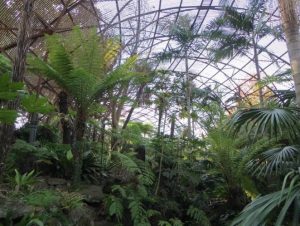
Rippon Lea was a family home with Frederick and his wife Marion having nine children. Sadly, Marion died in childbirth in 1879. In an attempt to escape his grief, Frederick took his children on an extended visit to England. While in England he married his second cousin, Julia, and his tenth child was born. In 1882 the family returned to Melbourne. Also on the return trip was Sargood’s newly acquired collection of orchids, and a gardener to care for them, Adam Anderson. Anderson had been an apprentice gardener at Chatsworth House in Derbyshire, home to the Duke of Devonshire, renowned for its orchid collection (Botham). Sargood employed top local landscaper of the day, William Sangster, to redesign the garden from the gardenesque style into the picturesque aesthetic. Visionary for the time, the ornamental gardens are irrigated from water held in a man-made lake, with run off from surrounding streets piped into the lake. Rippon Lea’s pleasure gardens developed into grand entertaining landscapes, with balls and receptions often held in the grounds, and the Pageant of Empire was held there in 1901, with the then styled HRH, the Duke and Duchess of Cornwell (later becoming HM, King George V and HM, Queen Mary) as guest of honour.
Sargood died in 1903 but he saw the creation of Rippon Lea, particularly the gardens, as his greatest achievement. Following Sargood’s death, the contents of the house and conservatories were sold at auction, with the catalogue listing many orchids. The estate was bought in 1904 by a syndicate headed by Sir Thomas Bent. In the five years before Bent’s death, 72 residential blocks were subdivided from the estate. Bent’s death saved Rippon Lea from future immediate destruction.
Benjamin Nathan purchased Rippon Lea in 1910. Nathan made his fortune from his share in the furniture and music retail chain, Maples. Nathan’s passion was for collecting plants, and “does not begrudge spending money on plant growing” (The Australasian 10/12/1910, p.13). Nathan, like Sargood before him, was especially passionate about collecting and cultivating orchids. Minutes from the Horticultural Improvement Society of Victoria (VHIS) make special mention of new species being displayed for the first time in Melbourne by his head gardener, James Dearing. Nathan continued to build grander conservatories for his expanding orchid and foliage plants collection, and in 1914 employed Arthur Stanley Orchard, another orchid specialist, to assist in the care of his beloved plants. The team of gardeners at one stage numbered 17 men. During the war years, Rippon Lea was open to raise funds for charities, and the conservatories were a highlight. Nathan also was an important financial sponsor of VHIS shows, with prize money and supply of a piano and furniture. Before his death in 1935, it was reported that Nathan’s orchid collection was over 2500 and housed in 21 glasshouses (Botham). Nathan’s daughter, Louisa, inherited Rippon Lea. She “modernised’ some rooms, added the current swimming pool, but did not have the same passion for plants as her father did. Glasshouses were dismantled and staff numbers reduced. The vegetable gardens became another housing subdivision, and the southern entrance was sold to become the ABC studios for the 1956 Olympic Games. Before her death in 1972 Louisa fought, with the aid of the National Trust, to fight compulsory acquisition of 4.1 acres.
Rippon Lea is open to the public daily and well worth a visit in any season.
With some research via the National Library of Australia’s TROVE and the manuscripts collection at the State Library of Victoria, a number of facts began to be complied about James Dearing. James was the fifth of six children, born 12th August, 1871 to William and Mary Ann (nee Mapley) Deering (with two e’s), near Aylesbury, Buckinghamshire. The Dearing family had lived in the area for generations. UK. Census records show his father’s occupation as agricultural labourer. James, aged about 15, and his family came to Australia on an assisted passage on The Eastminster in 1887 arriving in Maryborough January 1888. The ship sank the next month. James married Helen and they had a daughter, Ailsa. James travelled to England with his family a couple of times. James died in 1954.
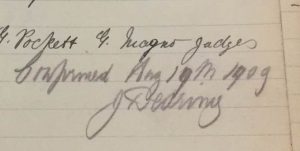
The Victorian Horticultural Improvement Society (VHIS) was established in 1860. This society is not to be confused with the Royal Horticultural Society (established 1849), the members being some of the leading figures of the colony. Dearing was to become heavily involved with the VHIS, being a committee member, vice president and later, president of the society. The VHIS was made up of professional and amateur gardeners who shared an interest and desire to cultivate all manner of plants. Meetings and shows were held regularly.
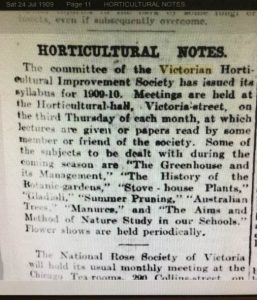
James Dearing originally worked for Nathan at ‘Dalnair’, in Armadale, and when Nathan moved to Rippon Lea, Dearing moved too. James Dearing was a keen gardener from a young age, receiving a highly commended award for 16 carnation seedlings staged at the VHIS meeting December 1893. Newspapers of the time reported on all manner of topics, and those of horticultural interest were a mainstay. Dearing was also a knowledgeable and skilled author of articles concerning, amongst other thing, ferns and stove plant cultivation. Dearing wrote a detailed article titled ‘Three foliage plants’ that was published in The Garden Gazette in 1903. In 1904 an article (printed over two weekends), concerning the cultivation of maidenhair fern was published by the Fitzroy City Press. Dearing, and his brother, William were regular exhibitors at the VHIS, winning awards for their efforts. Dearing presented papers at the VHIS meetings often, and the minutes of the general meeting of January, 1897 record that a motion was moved by Mr. Cheshire that Dearing’s paper on ‘A trip to Mt Bopple (sic), Queensland’ “was the very finest he had heard in the room”. (It should be Mt Bauple, Qld.) Dearing, after being vice president became president of the VHIS in 1909. The VHIS made links with similar bodies in the UK. One could assume Dearing was proficient at correspondence, especially before his trips to the UK. A newspaper article reports him winning all the awards in the foliage and palm section of the 1909 show held on the 17th of December (Leader, 25/12/1909).
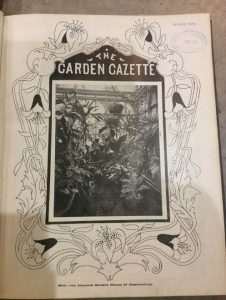
The Australasian wrote, “Dearing has proved himself to be one of the best plant-growers in the state.” The article goes on to compliment Dearing “who seems to know as much about horticultural architecture as he does about plant-growing.” (10/12/1910, p.13)
In the mid 1970’s Your Garden magazine, was a popular publication, costing 40 cents. In addition to a wide variety of general gardening articles, orchid cultivation had a section devoted to it, and also popular were advertisements for mail order plants. A number of businesses that advertised then are still in business today, including Bryan H. Tonkin. In addition to boxed adverts, the classified section ran for a number of pages and it is here we first find Fred Pollard selling, amongst other things, Clivia, from a home-based nursery called Hippeas. Pollard appeared to advertise every second month, and not unlike contemporary eBay sellers, seems to make a tidy amount of extra income from plant sales. His phone number was listed, and customers could visit his home. It is in Your Garden, 1980, December, p.21, that Fred, and his Clivia get special attention in an article, ‘Clivias worth waiting for’ (See last page of this newsletter for a reprint of the article). In this colour feature, reference to named plants, ‘Aurea’ and ‘Ailsa Dearing’ is made, saying they came from the collection of the late James Dearing. The Dearings lived at 27 Elizabeth Street, Elsternwick, just behind Rippon Lea estate and Fred and Joyce Pollard’s home in Caulfield was not far from both. A lack of oral history makes for guess work on how Pollard acquired the

plants, if he knew Dearing, or later, only his widow. In fact, how Dearing acquired ‘Aurea’ is somewhat a mystery, only that his daughter, Ailsa, speaking with Irene Broadbent a number of years ago, said that Nathan had instructed Dearing, while in the UK, to buy anything of note (Smith, 2000, p. 48).
The significance of ‘Aurea’ on the development of Clivia in Australia cannot be overstated. ‘Aurea’ has been used extensively as breeding plant by many Australian Clivia hybridists, including from Queensland, Kevin Walters, and in Victoria, Laurens Rijke and Helen Marriott.
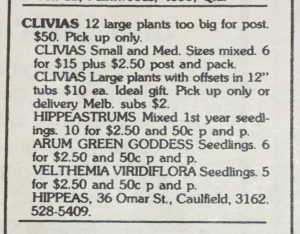
‘Aurea’ is well known as a one of the key plants used in Kevin Walter’s breeding work, with Walters buying his original plant from Pollard (Mathews, 2010 p.3). Nick Primich in a 1994 Clivia Club newsletter wrote, “I have an offset from the original ’Aurea’ from Kevin Walters. This is still the best yellow I have seen” (p 5). Kevin Walter’s continues, “All my yellow material stems from the original Aurea obtained somewhere in the seventies” (p.10) and surprisingly also writes, I have grown tired of developing round-headed beauties like “Relly Williams” which is Aura (sic) x ” Belgian hybrid”. Aurea gives the lovely round heads to its progeny” (p.6).
After seeing an ad in Your Garden, Laurens Rijke went to see Pollard and his Clivia in the early 1970s. He was able to buy on a couple of occasions, the limit of one per visit, of an offset of both ‘Aurea’ and ‘Ailsa Dearing’. He recalls that ‘Aurea’ was $25, a lot of money at the time, but recognised how special these plants were (Marriott, 2008). ‘Ailsa Dearing’ may now be considered not that special, but at the time, Laurens thought it was a vast improvement it was on the C. miniata normally seen in old gardens. He has continued to use ‘Aurea” in breeding work, sometime with interspecific crosses.
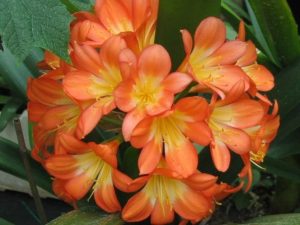
Helen Marriott met Joyce Pollard (Fred’s widow) when she moved into a unit in Armadale. Helen had already investigated Clivia as a plant to suit a shady situation in her back garden. As she got to know her neighbour, Mrs Pollard better, she was ‘introduced’ to Mrs Pollard’s special cream Clivia, called ‘Aurea’. Helen acquired a division, and has found it a strong grower and excellent breeding plant. Like Laurens, Helen has used ‘Aurea’ in breeding intraspecific and interspecific Clivia.
Jean Kent, and her daughter, Sally Kerr, sold offsets of ‘Aurea’ by the name of ‘Flowerdale Cream’. Sally still sells offsets, via eBay occasionally. The stories of how Jean Kent acquired the plants from Pollard vary slightly, but in either case, she was determined to get a piece of this
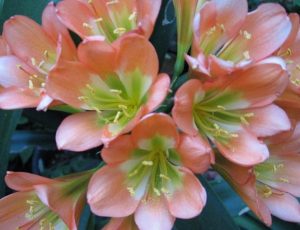
plant. One version has her chasing Pollard’s car, and in another, she leant against the car until the owner returned to be able to negotiate a purchase. It is called ‘Flowerdale’ after the road in Glen Iris where they lived.
‘Aurea’ is a significant part of the history of Clivia in Australia. Passionate and knowledgeable horticulturalists such as James Dearing have made lasting contributions to the improvement to, and our understanding of, many plant genera. Clivia enthusiasts are all the beneficiaries of earlier work and commitment by such great plant collectors.
(Editor’s note. Special thanks to Helen Marriott for her assistance with this article).
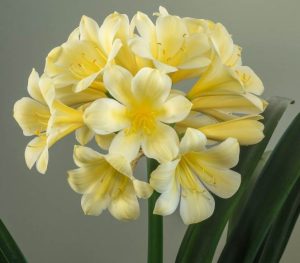
References and Future Reading
Botham, H. (2002) Pleasure in exotic treasures, Australian Garden History, 14, (2), 5-9.
Boyd, Peter D.A., Pteridomania – the Victoria passion for ferns, Antique Collecting, 28(6), 9-12 Accessed 8/2/17 http://www.peterboyd.com/pteridomania.htm
Boyd, Peter D.A., (2009) The Young Charles Darwin – student, naturalist and gardener, http://www.peterboyd.com/darwinyoung.htm
Clivia Club (1994) Newsletter, 3(4) 5-10.
Heathcote,R. Solid joys and lasting treasure: families and gardens. Accessed http://www.cv.vic.gov.au/stories/built-environment/rippon-lea-estate/solid-joys-and-lasting-treasure/
Mathews, D. (2010) Kevin Walters – An Australian Clivia breeder, Clivia News 19(2) 3-5
Marriott, H, (2008) Laurens Rijke- A passionate Collector of Clivia, Clivia Yearbook 10
Purdy, G. (1988) A classic fernery, Your Garden, September 92-93.
Smith, K. (2000) Named cultivars of Clivia in Australia, Clivia Yearbook 2, 48-54.

